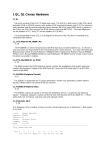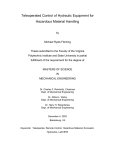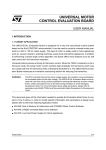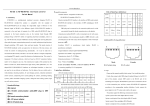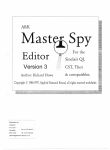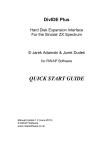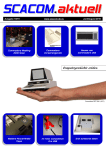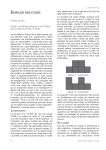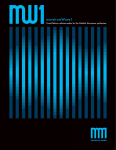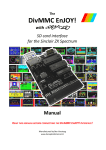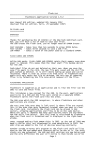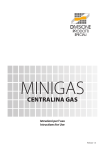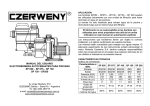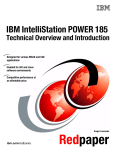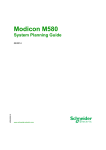Download Z88 USER - Virtual TR-DOS
Transcript
Z88 USER Issue 7 The NEW magazine for Spectrum, Z88 and Emulators IN THIS ISSUE: New editor drives magazine into the ground ;-) Latest Z88 software reviewed Dennis ‘Pipeview’ Groning interviewed Hacked Off: Jet Set Willy Dissected Spectrum clones from around the world Retro computing - big business muscles in AlchNews Issue 33 CONTENTS 2 CONTENTS & THANKS. Details of the articles I managed to blag for this issue. 3 EDITORIAL. A warm welcome to a new magazine. 4-5 NEWS. What’s happening. 5 WORD ON THE WEB. Some excellent sites. 6-8 BACK TO BASICS. Ken Beer looks at Sound, data and logical operators. 9-10 THE 80-LEC ROM. A new and feature filled ROM image. 11-15 HACKED OFF: JET SET WILLY. Celebrate JSW reaching the Z88 by disassembling it. 16-17 SOLVE THE CRIME. Can you find the solution to this short mystery? 18-21 RIVAL RAGS. A look at other paper based publications you can waste your mo…. Erm, I mean invest in. 22-29 SEND IN THE CLONES. Thought that the Pentagon and Scorpion were the only Spectrum clones? Prepare to be amazed at the ingenuity of Eastern Europeans! 30-31 RETROGAMING. What’s the future of old computing? 32-33 THE DENNIS GRONING INTERVIEW. A peek into the life of this remarkable Z88 programmer. 34 TRADING POST. 35 SUBSCRIPTION and ORDER DETAILS. 36 W.N. Richardson & Co. Advert. THANKS An IMMENSE thank you to the following people: BILL RICHARDSON for getting me to finally move to a paper production - I didn’t want to but it’s too late now! PAUL WHITE, for launching an excellent magazine for me to copy! Excpect legal action forcing us to close! DARREN BRANAGH for starting the Z88 magazine for me! GARRY LANCASTER and DOMINIC MORRIS for their outstanding contributions in keeping the Z88 alive. KEN BEER for his excellent programming series and DENNIS GRONING for allowing me to protrude into his personal life. Thanks to everyone else who had a hand in this magazine and a big thank you for buying it and keeping the faith in the magazine, the Spectrum & Z88 and me! EDITORIAL W ELCOME! This is a gigantic step for me. Not only have I taken on both editing and publishing the world’s leading Z88 magazine, but I have ended AlchNews– my long running electronic Sinclair magazine. It was a tough decision but I think it has helped save both magazines. I always wanted AlchNews to be a paper magazine so that readers had the flexibility of reading it anywhere, but I didn’t want to tread on the toes of other Sinclair publications and didn’t have the DTP facilities. Now, there are only a small handful of magazines—all covering widely different areas and I have a fantastic DTP set-up, so, if it looks crap, it’s entirely down to my poor visualisation skills! I’ve spent all my years doing an electronic magazine that could not be changed very easily, having a powerful publishing system and access to thousands of fonts is a very daunting thought. I had to come up with a basic design layout and small set of fonts that are easy on the eye and don’t make the magazine look jumbled or tacky. Thankfully my partner, Linzi, is more experienced in these matters. Being a teacher, she is used to knocking up flyers and handouts all the time. I will desperately miss the electronic version of the magazine, but it was extremely time consuming to create. It had thousands of readers who downloaded it for free from the Internet, I hope that many will take the plunge and subscribe. This magazine is intended for ALL Sinclair machines, but with a strong emphasis on the Z88, Spectrum and emulators. The emulation scene is very popular for those with little space for all those classic beasties and gives you a dozen machines for just a few pounds. The Spectrum scene is now very small with most new programs, projects and ideas for the Z88 and Pentagon machines, so we must look to these areas if we don’t want a magazine of empty pages. This is where YOU come in. It’s been said many times before that any magazine is “your magazine and we need your input”, but it’s true. We need to hear what you’re doing with your machines and what you’d like to see. One thing AlchNews wasn’t able to accommodate previously was pictures. So, let’s have the magazine brightened up by as many pictures and diagrams as possible! Contributions are welcomed on all formats and we will return anything you send and credit you with a free issue for your efforts. I’d also like to hear your comments on the name. Z88 User is not as long established as AlchNews and we don’t wish people to think we are a Z88 only magazine but, unfortunately, all the best names have been taken, with the exception of Spectrum News, & Spectrum World. What do you think? A few years ago AlchNews merged with a Dutch magazine with the unusual title of Uncle Clive & Uncle Sam. The editor wanted us to keep that name but readers wrote in their hundreds demanding that the AlchNews name be kept. This led to a bit of consternation between us both and we sadly parted company shortly after, AlchNews returning to it’s old format. The magazine is scheduled to be bimonthly. This is attainable if we receive enough material. If not, it will revert to a quarterly publication. The price, I hope, will represent good value for money. It’s not my intention to make money from it, I already have a good, well-paid job. I just want it to break even, run a well enjoyed magazine and well respected in the tradition that AlchNews was for almost ten years. So, here’s to the next ten of ANZU, or whatever name you decide is best! Andy Davis Editor & Publisher. NEWS MARTYN SHERWOOD IN TROUBLE? What better way to launch a new magazine with a fresh attack on Martin Sherwood? Heh heh, only kidding, but CRASHED magazine number 30 in “Spectrum buffoon In Trouble Again” reports that Paul Sneesby, author of the excellent PCG desktop publishing software package, has been incensed to find that his software has been illegally sold for years. Paul claimed that Mr. Sherwood “is a rip off merchant pure and simple”. Paul now wants anyone who has purchased the package from Mr. Sherwood or any of his ‘companies’ to get in touch. You can contact Paul via the Crashed address or email: PSNEESBY@FSMAIL.NET. Legal action against software piracy has been much heavier than in the past. A rap on the knuckles has now been replaced with huge fines, confiscation of equipment and even prison sentences. Mr. Sherwood has previously been accused of illegally selling a number of programs, including AlchNews and the work of Miles Kinloch, and was severely criticised for running a poor software service which led him to become a social outcast in the Spectrum community. THE SHOW’S NOT OVER…. Until the fat bird sings. And there are none in site. That couldn’t be a more obscure link to Spectrum shows! Following a half decent QL show in Manchester in May, ANZU and a small group hope to revive the NSS Shows, with one being hosted in the same area as the Horwich show before the end of the year. A venue has been considered and is available, all that’s needed now is a lot of support and some DEFINETE promises from people to actually turn up. We hope to have concrete details in the next issue of this and all other magazines. eBAY TO START CHARGING One of the best auction sites, eBay, is to introduce a fee for using it’s service from the 4th July 2000. eBay has become very popular with the on-line Sinclair community for it features dozens of Sinclair items for sale on a daily basis - from single cassette games to boxed Spectrums and ZX-81s in pristine condition. However, it has also received criticism with it’s greedy sellers asking extortionate prices for equipment which can’t even be seen or inspected. eBay claims that introducing the charges will attract more buyers looking for “quality items”. What it will do is put off people from auctioning small items, such as the odd game, since the fee will have to be deducted from the final auction price. See the article on retro gaming later in this issue for more details. CRASHED 32 IS “BEST EVER” Big congratulations to Dave Fountain. Z88 DK V1.32 The latest version of the Z88 Development Kit, by Dominic Morris, is now available for download on z88dk.sourceforge.net. The latest version renders a couple of bugs fixed and support for new machines. PAUL WHITE IS BACK I’m not usually one for stalking but, by chance, I was in Wetherby at the end of June, so I thought I’d drop in on ‘missing’ magazine editor Paul White to see how he was. Unfortunately (but lucky for him) he wasn’t home, but he did email me shortly after. Paul’s been away from the scene because there’s been so little happening. He has promised to return with a second paper issue of Z88 Gamer before the magazine becomes a web-based affair. And we’d all thought he’d done a Matthew Smith! NEW ROMCOMBINER Z88 FAQ LAUNCHED Most old computers have them, so what better time to launch the Z88 FAQ, a simple text file of frequently asked questions relating to the Z88. Compiled by myself, with help from all the leading names in the Z88 world, the FAQ aims to cover every general aspect of the Z88, without treading on the toes of the already established Z88 Source Book by Tim Swenson. The FAQ can be downloaded from our web site http://go.to/ alchemistresearch, and will be published in the next issue. A new version of that old favourite, ROMCombiner, now at version 2.01. Don't expect any major advances - just a few bugfixes and a couple of minor improvements, but definitely worth dumping your old version for. It’s at: http://www. z88forever.org.uk/ WORD ON THE WEB THE WORLD OF SPECTRUM http://www.void.jump.org/index.html Without a doubt, the first place to go for anything Spectrum. Daily updates on emulators, software, tools and news. A big campaigner in getting old commercial titles placed in the public domain. PHILIP KENDALL’S THE SINCLAIR SPECTRUM http://www.ast.cam.ac.uk/~pak/spectrum/index.html Philip maintains the Sinclair FAQ - a comprehensive guide to the Spectrum on the internet. If you have a question, don’t embarrass yourself by asking it or getting serious verbal abuse from nerds who need to be taught a lesson in manners, visit this site and download the guide. JEREMY SMITH’S RETRO READING http://members.netscapeonline.co.uk/jeremyalansmith/level9/ Remember when games were games and came in gigantic boxes with 50 pages manuals and, in the case of Driller, a cardboard planet to asssemble? Jeremy Smith has painstakingly transferred the novels that came with games such as Driller, Elite and Peter McBride’s Level-9 adventure novels. YOUR SPECTRUM ARCHIVE http://www.users.globalnet.co.uk/~jimg/ Jim Grimwood’s tribute to the finest Spectrum magazine ever,. MATT WESTCOTT’S DEMOTOPIA http://www.demo.eu.org/ Your one-stop-shop for demos. MORE NEXT ISSUE BACK TO BASICS Ken Beer READ & DATA Commands Up to now we have been entering data at the keyboard in response to an INPUT command. Another way to get data into a program is to store it in a DATA command within the program itself, and to READ the items of data from these DATA commands. Note. DATA is obtained by pressing 'D' key when in the extended mode E. READ is similarly obtained by pressing key 'A' when in the extended mode. (ReminderExtended mode=press CAPS SHIFT and SYMBOL SHIFT together). Each time the computer comes to a READ command, it takes an item of data from the data list and assigns it to the variable specified in the READ command. Try this simple program: 10 READ a 20 PRINT a 30 DATA 10 Not very exciting ! but where READ & DATA statements come into their own is when there is a large number of data items to be entered. In each case READ is assigned a letter if the Data items are numeric. However, the Data can be in string form, in which case the a$ to z$ sign has to be used for READ items and as usual when using string characters each item must be enclosed within inverted commas. Also, separation commas both for Read & DATA statements must follow each separate item. The following is an example of numerical characters: 10 READ a, b, c 20 PRINT a 30 PRINT b 40 PRINT c 50 DATA 10, 20, 30 There must always be the same number of data items as READ items. If there is less, then the computer will display the Error message: E Out of DATA followed by the line number on which the error occurred. Here is an example of the string form 10 READ a$, b$, c$ 20 PRINT a$ 30 PRINT b$ 40 PRINT c$ 50 DATA "TOM", "HARRY" "DICK", You can of course mix numeric and string providing you obey the rules above e.g. 10 READ a$,b,c,d$ 20 PRINT a$ 30 PRINT b 40 PRINT c 50 PRINT d$ 60 DATA "FRED" , 3 , 9, "TED" SPECTRUM SOUND Now I am going to talk about the sounds that the Spectrum can produce and how to program it. The Spectrum has an inbuilt loudspeaker through which it emits the required sound in response to the program fed to it. The BEEP command controls all sound programs. This takes the following form: BEEP, duration, pitch Where pitch is the pitch of the sound and duration is the approximate length of time in seconds that the sound is emitted. Note. 'BEEP" is obtained by selecting the extended mode E and Symbol Shift and key marked 'Z'. 30 40 50 60 As a sampler try these: 10 BEEP .1, 5 20 PAUSE 15 30 BEEP .1, 10 50 BEEP .1, 15 60 PAUSE 15 70 BEEP .1, 20 80 PAUSE 15 90 GOTO 10 PRINT BEEP NEXT DATA P 0.5,P K 0, 2, 4, 5, 7, 9, 11, 12 I wish you luck in making your music ! I now want to talk about decisions which the SPECTRUM can make. Up to now, the programs which we have been considering have worked through a program list in the order in which it is written. However, life is full of 'decision making' For example Or: IF you are tired THEN you rest or go to bed. 10 FOR n=1 TO 20 20 BEEP .1, n 30 NEXT n 40 PAUSE 15 IF you are thirsty THEN you make a cup of tea. We can relate pitch values to musical notes as follows: Pitch Note (Middle) 0 2 4 5 7 9 11 12 C D E F G A B C Minim Crochet Quaver Semi-quaver Time Unit 2 1 0.5 0.25 The IF......THEN command Duration (Secs) 1 0.5 0.25 0.125 And finally, a musical scale using the READ & DATA commands we learnt about above: 10 FOR K = 1 TO 8 20 READ P Decision making is one of the most useful tasks that the computer can fulfil and is of the same form as the example shown above i.e. the BASIC command for the instruction is : IF some condition THEN take some action. If you are musically inclined you should be able to relate duration to note duration i.e. Assuming a basic time duration of say 0.5 second, Perhaps a Minim could represent 2 time units = 1.0 sec. Note etc.,etc. The form that the SPECTRUM uses is to look to see if some particular condition is TRUE or FALSE. It does this by employing the following symbols: = > < >= <= <> which obviously means "equals" which means " is greater than" which means "is less than" which means "is greater than OR equal to" which means "is less than OR equal to" which means "is not equal to" Let us now put this to use in a simple program. Let us assume that there is a class of boys with ages ranging between 7 and 12 years of age, and only those under 10 years may participate in a particular function. You want the computer to tell you which ages are permissable: 10 FOR a =7 TO 12 20 PRINT a ; 30 IF a < 10 THEN PRINT " This is young enough"; 40 IF a > 9 THEN PRINT " This is too old"; 50 PRINT 60 NEXT a Incidentally, did you notice that the printouts were not aligned vertically? This is because 7,8,9 are single digits but 10,11 and 12 have double digits. This can easily be corrected by using the TAB function. Change line 20 to read: 20 PRINT a; TAB 3; Now, let us play Guess the number game (for 2 players)10 REM Guess the number 20 INPUT "Enter a number", a : CLS 30 INPUT "Guess the number", b 40 IF b = a THEN PRINT "That is correct ": STOP 50 IF b < a THEN PRINT "That is too small,try again" 60 IF b > a THEN PRINT "That is too big, try again" 70 GOTO 30 Note. CLS in line 20 clears the screen to prevent the other person from seeing the secret number. 'IF....THEN may used with other instructions other than PRINT, and one of the most common uses is to make an Unconditional Jump to another line, an example of which is shown below: 10 REM Count to seven 20 LET counter = 1 30 PRINT counter 40 Let counter = counter + 1 50 IF counter <= 7 THEN GOTO 30 MORE DECISIONS There is a feature of Spectrum BASIC, which not all computers have. There are the special expressions known as logical operators. These are OR, AND, NOT. From these we get a result which is once again TRUE or FALSE; for example in 30 IF i < 10 OR j >20 THEN GO TO 66 The meaning of OR is something OR something is TRUE if either of the somethings are TRUE. This includes the case where both somethings are TRUE. When the AND operator is used, this means something AND something is TRUE only when both somethings are TRUE. Finally, when the NOT operator is used, this means NOT something is TRUE when the something is FALSE and vice versa I hope that this doesn't sound too much like Double-Dutch, but I believe that if you think about it carefully it will become clear to you. A good example of AND, NOT and OR can be found with the program MAKE A CHIP. A truth table is a helpful thing to explain this more clearly. If we set Logic 1 = TRUE and logic 0 = FALSE then we get the following relationships: OR FUNCTION AND FUNCTION NOT FUNCTION 0 OR O = 0 0 AND 0 NOT 0 = 1 1 OR 0 = 1 1 AND 0 NOT 1 = 0 0 OR 1 = 1 0 AND 1 = 0 1 OR 1 = 1 1 AND 1 = 1 KB. = 0 = 0 TheDisassembled 80-lec ROM by Zeljko Juric This is yet another ROM file, the source of it is unknown to me, but this is a list of features, discovered using the disasembler. Startup menu After startup, a menu appears, with following options: BASIC Enter the basic MONITOR Enter the monitor see below) BOOT Load and run 'run' file from the microdrive Detokenized keyboard expansion, in which upper 32 K of RAM is paged. Namely, in according to ROM dissasembly, it seems that in this expansion FIRST 32 K is paged (address 0-32767) using bit 7 of port 253, with following meaning: b0=0 : standard configuration (0-16383 ROM, 16384-32767 standard RAM) b0=1 : 0-32767 extra 32K RAM Extra BASIC commands: This ROM has 4 new BASIC commands (more precise, a new meaning of existing ones) This ROM has detokenized keyboard input. The tokenizer routine is good: keywords may be entered both in capitals and lower letters, and a space between GO and TO in GO TO command (or GO SUB, DEF FN etc.) is not necessary. Space is not necessary after a command (so, PRINT1 is acceptable), except when the argument begin with letter (e.g., PRINTA is not acceptable). If you prefer tokenized keyboard, you can turn detokenized keyboard input off using basic command: CAT FORMAT "k" ERASE "i" erases extra Interface 1 variables, extended channels etc. without affecting the BASIC program in memory; other forms of ERASE work as usual. The same command given again will turn on tokenized input again. This is controlled via bit 7 in FLAGS2 (address 23658). CAT without parameters enter the monitor, else works as usual. FORMAT: FORMAT "k" turns on or off tokenized keyboard; other forms of FORMAT work as usual. ERASE MOVE Extended editor During editing a long line, it is possible to move cursor up and down. 80 K support This ROM has extended BASIC command (MOVE) for supported Spectrum expanded to 80 K (see below). I don't know which is producer of supported expansion, but it seems that it is not the most usual 80 K This is the most complex extra command, with the following syntax: MOVE "<src_code><src_addr>, <src_len>","<dest_code><dest_addr>" This will move <src_len> bytes from <src_addr> to <dest_addr>. <src_code> and <dest_code> may be "r" with meaning "standard ROM/RAM" and "d" with meaning "extra 32K RAM". Try for example (on the emulator): R View and/or change registers AF, BC, DE, HL, IX and SP. S<addr> Patch memory from given address using hex editor (enter just space to exit hex editor). A new interrupt routine MOVE "r0,6144","r16384" An expressions are allowed between quotes. Other forms of MOVE works as usual. This syntax seems strange (parameters as part of a string), but obviously author wants to preserve original syntax of MOVE <string>,<string>. The standard interrupt routine is changed, so pressing SYMBOL SHIFT, SPACE and B simultaneously will enter the monitor (except when interrupts are disabled, or when IM 2 mode is used without calling RST 56). Also, NMI bug is corrected (NMI is redirected via NMIADD if <>0). Monitor Other changes The monitor has following commands (all parameters except for command H are hex numbers): Changed startup parameters (black-onwhite screen, keyboard click, autorepeat speed). B: A new screen font. Warm exit to BASIC (if possible) D<hex_num> Displays entered hex number in decimal notation Corrected CHR$ 8 and CHR$ 9 bug. G<addr> Execute a subroutine at address G (RET will return to the monitor). Corrected WAIT_KEY bug during displaying of "scroll?" message, etc. H<dec_num> Displays entered decimal number in hex notation Corrected CLOSE bug (crash on CLOSE #4 without Interface 1 if stream 4 is not open). M<addr> Hex and ASCII dump from given address (space for exit). Shorter delay between header and block during saving. ZJ HACKED OFF: JET SET WILLY Without a doubt, the finest game—not just of the 80’s but ever - is most certainly Jet Set Willy. Mention a Spectrum to anyone and that it one of the games they’ll recall along with it’s predecessor Manic Miner. Now it’s been ported to the Z88, what better way to celebrate than to hack it apart again! The game is colourful, fast and ingenious. The controls are simple; you can move left or right and you can jump effortlessly into the air. And that's all there is to it, except, of course, that this is where all your problems begin! HERE WE GO. Every now and then, there comes a program that somehow prevents reviews from being written in a hurry simply because tapping typewriter keys is cold comfort after you've negotiated the perilous journey up The megatrunk, or collected the goodies from The Forgotten Abbey, or entered The Chapel and lived, or……. Press Enter and you're whisked from the title page to your first glimpse of Willy's 60room mansion. That's you standing in the bath, staring at a flashing tap and a toilet (complete with moving seat (a la Manic Star of the Speccy screen, Matthew Smith, delivered his follow up to Manic Miner, and it's every bit as good and refreshing as the original. The story line is as weak as ever & some nonsense about Willy having thrown a party and the guests having left lots of champagne glasses strewn about his mansion (altered slightly in the production version). The aim is for him to collect all of these, because his housekeeper won't let him into the bedroom until he has. Weak it may be, still 'it's the game itself what matters'. Miner). The moral of the game is that virtually everything that isn't flashing will kill you should you be foolish enough to walk into it. You've guessed it ... the flashing objects are the ones you have to collect; there are 83 of them in all and the majority are very difficult to find indeed. At the bottom of the screen, there's an indication of time. You begin your quest at seven in the morning (it must have been one heck of a party!) and the idea is to get into your bedroom by the hour of midnight. No, that doesn't mean you'll be sitting at the keyboard for 17 hours (although that wouldn't surprise me) for Matthew has thoughtfully shortened each minute to around 40 seconds. vain atttempt to prevent the inevitable. When you begin playing you start with eight lives, which at first seems a bit excessive (ho ho) until you venture past The Bathroom. It's worthwhile just having a wander around to get a feel for the way Miner Willy handles; for example, you can get Willy to hang precariously to a surface by what looks like a single pixel before making that important leap, and in some cases that's exactly what you'll have to do. BATHTIME'S OVER! Another strange quirk is the way in which the rooms have been laid out. The top floor seems to have more rooms than the floor below, and the basement has even fewer. For instance, if you go from The Wine Cellar into the next room, you'll end up in The Forgotten Abbey - which according to my calculations is right over the other side of the mansion! You can also reach some strange places by getting to the highest point of some rooms and jumping up. The first experience of this came after a timely leap from Rescue Esmerelda, which sent poor Willy headlong into the floor off Ballroom East. Also, if you try jumping off most of the other rooms on the top floor, Willy ends up in The Off Licence. Whether this just shows Matthew Smith's alcoholic sense of humour, I'll probably never know, but after a few hours of Jet Set Willy, it turns out not to be a bad suggestion at all. The main approach to mapping out this One step out of The Bathroom and you're thrust into the thick of Matthew Smith's fertile imagination, and what a place that must be! You can forget all about malevolent space invaders and greedy Pacpersons, here the baddies are Swiss Army knives, razor blades, mini-chefs, grotesque faces, wobbling jellies, rolling eggs, balletdancing gerbils, a Monty Python foot, and…. need I go on? That's not all you have to watch out for. The program has a nasty habit of thrusting you on-screen in a room you've just lost a life in - leaving you powerless to prevent all the remaining lives being eaten up in the same way. Try making some of the leaps across The Orangery, for instance. Should you miss your footing you're likely to end up falling down into The Swimming Pool and dying. The rest of your lives will then automatically be swallowed up in the same way, leaving you impotent with rage and uselessly hitting every key in sight, in a vast playing area was simply one of striking out with eight meagre lives, in an attempt to find all the rooms. Having located around 45 of them, there is a bug: each time you walked into certain rooms, Willy lost all his lives. Alan Morton of Software Projects said: "That's just a little something we put in to make it a bit more difficult". A bug or a 'feature'? Methinks Alan Morton gave lessons to Bill Gates! Indeed, it does make the game "a bit more difficult" - in fact, nigh on impossible to be precise. Once you visit The Attic, the four guardians from The Chapel race off to guard the entrances to The Kitchen, West of Kitchen, Cuckoo's Nest and East Wall Base. So, for goodness sake remember to check these places out first (and all rooms beyond) before you set foot in The Attic otherwise you'll only have to reload the program again and start over. Another clever little trick you discover, even before getting to indulge in the delights of the game, is the way Matthew Smith has chosen to 'anti-pirate' his program. Using a colour chart you have to type in a code of four colours which you access from the chart via co-ordinates flashed on-screen. This was soon worked around by a simple POKE. Like Manic Miner, Jet Set Willy has a charm, which sets it aside from virtually every other game on the market. On a per- retrieve without sacrificing a life. For instance, there's a tricky one to get on the third level of the Cold Store, a couple in the Wine Cellar, and the one in the Nightmare Room; this is made even more difficult by the sudden transformation of the Miner Willy character into an awkward flying pig shape. But if you really want to set yourself a task, try going after the goodies on the Conservatory Roof and see how well you make out. If you enjoyed Manic Miner, then Willy is going to seem like the proverbial manna from heaven. Matthew Smith seems to have incorporated the best of his original creation, let none of his apparent fame spoil his wonderful sense of humour, and firmly set the blueprint for all other platform games to follow. POKED TO DEATH sonal level, I find Jet Set Willy to be infinitely superior to its predecessor - if only because a practised Jet Setter can travel throughout the entire mansion without dying Most of the objects cached in Jet Set Willy are attainable, but there are some, which, even when working from carefully scaled maps of each room, seem impossible to There are certainly no shortage of POKEs and cheats for Jet Set Willy. Here are the most popular: 34785,x-1 35899,0 34795,x 41983,256-x 34275,10 41983,255 59900,255 ‘x’ lives (maximum 32) Infinite lives Start room, normally 33. See prev. page Number of objects to collect, normally 83. Warp anywhere. Collect only 1 item Fix attic bug THE ALTERNATIVE SPECCY FANZINE 11 CAMEl road, Silvertown London, E16 2de game. To acces it, go to the First Landing and get to the lowest level. Then type in WRITETYPER, making sure that Willy doesn’t wander up the ladder. Then, pressing the combination of keys in the table on the previous page will take you to that room. You can also enable this cheat with the Warp Anywhere POKE featured in the list. There are quite a few more POKEs out there, including one which turns the penknife into a top hat, I’ll leave those to you! 36545,0 36358,0 36477,1 37982,0 34480,195 34481,202 34481,135 Banyan Tree easier Super jumps! Fall from any height Walk though monsters By-pass colour code If you don’t have a Multiface – and if you have a Z88 that is definetlly you (!), you will need to use a loader. Just add your pokes after line 3: 1 CLEAR 32767 2 LOAD””CODE 3 REM enter pokes here 9 RANDOMIZE USR 33792 WARPING Like in Manic Miner, there i a special ‘warp’ feature which takes you to any room in the SOLVE THE CRIME diately. I ordered my staff not to touch anything and I telephoned you." Bourne indicated his desk. "The locked drawer has been levered open and ransacked and you can see how the thief broke in." The Puzzle of the Pirated Software Holmes' piercing eyes swept the room, taking in the rifled desk and the broken window behind it. Through the smashed pane he could see the fire escape outside, littered with shards of glass. The idea of this section is for you to deduce who the thief is and give your reasons for your deduction. After you have done this read "Solve the Crime - Solution" to see if you were right. Here is an extract from the memoirs of Doctor Watson: The various investigations on which I was fortunate to accompany Sherlock Holmes jnr., the grandson of the famous detective, frequently left me baffled and bewildered, though to Holmes the confusion of alibis, clues and lies always appeared crystal clear. One such instance was the Peculiar Puzzle of the Pirated Software. One April morning, Holmes and I were summoned to the offices of Classic Software Ltd., where a break-in had been discovered. On arrival we were met on the first floor by Mel Bourne, the manager. Visibly agitated, he led us into his office, where the three members of his staff were assembled. "I was first to arrive this morning and discovered the break-in imme- "Interesting," he mused. "Tell me, what appears to have been stolen?" "That's just it," exclaimed the exasperated Bourne. "Absolutely nothing. The only thing of value was this" - and he held up a cassette. "Our latest game. Our rival, Moriarty Micros, would pay a small fortune to get their hands on this." "Perhaps they did," I interjected, "and merely substituted another cassette." Holmes slapped me on the back. "Brilliant, Watson. You have a mind like a rapier. I suggest we load the tape into the office Spectrum without further ado." Bourne's secretary, Penny Traitor, led the way to the computer room. An untidy mound of hardware and software, trailing wires and cables, covered the table. Moving a pile of blank cassettes to one side, Holmes idly picked up the Spec- trum and put it down again hurriedly. It was surprisingly hot. "I'll get Terry Dactill, our programmer, to load it for you. I'm all fingers and thumbs when it comes to computers," Miss Traitor confessed and she turned to the bespectacled Dactill, who placed the cassette swiftly in the tape deck, rewound it and began the loading procedure. While we waited Dactill related the events of the previous afternoon. "At about 4.30 I had put the final touches to the game and I called the others in to see it. The four of us played it for almost an hour. It's very addictive, I'm proud to say." "I'll second that," added Horace Goezski, the public relations man. "It's a kind of snakes and ladders thing called Lord of the Rungs. Damnably tricky, too; I was hopeless at it." Dactill took up the story again. "At 5.30 we decided we had better go home and, after rewinding the cassette, I gave it to Mel for safe keeping. The others followed him into his office and stood chatting while I unplugged the equipment in here." Bourne nodded. "That's correct. I locked the cassette in my desk - normally I use the safe but as we were late I put it in the top drawer and removed the key. Terry joined us and we all left the building together, Penny locking the main door behind us." The cassette had finished loading by this time and within minutes of running it was clear that it had not been altered in any way. As the game ended the hi-score chart was displayed. It read: MEL TER HOR PEN 11073 9912 7231 654 Holmes took out his pipe and lit it, as he was accustomed to do when he had found the solution to a crime. "One final question," he said. "Who has keys to the building?" "Myself, and Terry," replied Bourne. "Why do you ask? It seems we have been wasting your time, as nothing appears to have been taken after all." Sherlock Holmes looked up and said, gravely: "I'm afraid you're wrong. A theft has occurred and I'm confident that at this moment Moriarty Micros is duplicating Lord of the Rungs by the thousand." "Good grief, Holmes," I spluttered. "How on earth do you know that?" Holmes turned to me and, in the manner of one speaking to a child, said, "Elementary, my dear Watson ...." Answer next issue. RIVAL RAGS Now That AlchNews is a paper magazine, we are entering an arena with a handful of others. Never one to put others down (unless they are really shit and deserve a beating), we felt it only fair to let our readers know what other magazines are available. articles and information from the internet, Dave goes out of his way to find exclusive news and programs. He’s not afraid to say what he thinks and regularly dedicates part of the magazine to porn. For any other magazine this would be instant death but works for Crashed and Crashed alone. Another remarkable point to note is that Crashed is created entirely on a Spectrum. While this is noticeable with the screen pictures, all text is clear and very easy to read. If you’ve never read it, then shame on you. Crashed is required reading for the Spectrum and should be the first choice of subscription for any user still remotely interested in the scene. Name: CRASHED Format: Bi-Monthly A4 Price: £1.50 (UK) Crashed has been around for years. Currently on issue 32 and it’s fourth editor (previously Stewart Skardon, Mark Sturdy [twice] and Allan Clarkson), Dave Fountain has taken the magazine to new heights by dedicating far more time and energy than the previous editors were able to put into it. The magazine has become to the Spectrum what OUTLET was to software. It’s strengths lie in not taking itself too seriously. In fact, Dave openly admits to spending the subscriptions on beer and fags (well, he does to me!). Unlike other magazines, which blatantly just rip POKEs, Name: DESERT ISLAND DISKS Format: Bi-Monthly A4 Price: £2 (UK) Desert Island Disks, or DID as it’s known to lazy typists is a relevant newcomer, launched in mid-1999 by Michael Bruhn. This magazine has two incredible strengths which make it stand out. First, it has a Danish editor. His command of the English language is remarkable and you’d be very hard pressed to find grammatical errors. The second is the amazing fact that it’s printed in full colour. How many other home-grown magazines, past or present, can boast this? The main content of DID is games, both past and present, a small smidgeon of news, articles from well known names such as St.John Swainson, POKEs, solutions and Spectrum internet information. At £2, DID is a little more expensive than other publications. But, you pay for the quality and presentation, and that is high. STOP PRESS: Dave Fountain reports that the magazine has closed. We were unable to confirm this at time of going to press. Name: HACKER’S HANGOUT Format: Infrequent A4 Price: £2.50 for THREE issues Now here’s a magazine which couldn’t be more different than DID. Hacker’s Hangout is all out quantity than presentation. With no-less than forty single sided A4 pages, it is a complete tech-fest. The editor, Andy Ryals, gives unbelievable value for money. Despite the name, HH isn’t just a hacking magazine. It contains a small news page, the odd review and then tons of technical data. The last issue (nine) featured the compete history of software protection systems used with TR-DOS. There are also regulars, such as letters, POKEs, BASIC listings, a hacked adventure, passwords, reader adverts and a comprehensive guide to all back issues. Name: QL TODAY Format: Bi-monthly A4 Price: Contact magazine for details QL Today first came into my hands courtesy of Bill richardson to give me a bit of background information for a QL show in Manchester that I was to attend. And I was quite amazed at how far the QL has come. I was an owner back in 1986 but soon sold it because of it’s poor support and expensive microdrive cartridges. But, things have changed since then - a 3.5” floppy drive is now de rigueur. The magazine consists of sixty very high quality pages., and covers the QL, QL clones and QL emulators for many machines. The magazine was a little too technical in places, and many references were given to machines and hardware that I had no idea were. A section for new users would be invaluable, especially those who may have owned a machine in the past and have now returned to the scene with an emulator. expanded Alchemist PD tremendously. The magazine is in German, but don’t let that put you off. A number of articles are in English and there are plenty of screenshots of the latest software for you to understand what’s happening. There’s a decent balance of material for Spectrum, SAM and emulators and features regular news slots, letters, demos and in-depth technical articles. SPC is a great magazine, well presented and an enjoyable read. All the best to it’s editors Wolfgang & Monika Haller, long may it continue. That aside, this is a feature packed magazine with no lulls in the in-depth information. Name: SPC MAGAZINE Format: Bi-monthly A5 Price: Contact magazine for rates The SPC magazine has been coming to me on a monthly basis ever since I first made contact with the group several years ago to exchange PD. They supplied us with over thirty disks of software and Name: SUC-SESSION Format: Bi-monthly A5 Price: 10DM (with SCENE+ diskzine) Suc-Session is another magazine which has been coming to me along with the SPC. Again, it’s German but that shouldn’t discourage you. The magazine has a very good news page, peppered with plenty of pictures. There are plenty of tips & tricks, solutions and reviews. It’s also backed up by the might of the Sintech business - a large organisation dedicated to selling hardware and software. Prices are very reasonable and you’d be hard pressed to get such gems as a Multiface or MB-02 disk interface so easily from elsewhere in this day and age. eyebrows up/down The Gary Barlow of the Spectrum world indeed.” “Calling itself the UK’s No.1 mag, the best value mag and the best read on the Speccy scene really is making a rod for its own back. It will come as no surprise that PD Power fails on every count in a very glorious foot shooting exercise, for it is currently limping in last place, and would be fourth if Hackers Hangout was an applicable all rounder. PD Power sucks ass” “Issue 35 weighed in at 40 A5 pages, eight whole pages were advertisements, eight more taken up by software lists, 5 pages featured how to (vaguely) build your own anemometer (no missus, don’t all orgasm at once), two pages were lifted from a very old issue of Outlet reviewing the TK50 toolkit, half the news struggled to maintain a Spectrum flavour and the other half was lifted from an old Crashed. The contacts section is severely out of date, there were no new games featured and no new demos mentioned. These are the facts ladies and gentlemen, and that rod is sticking out so far you could hang a weeks washing on it. If it wasn’t for the embarrassing self promotion, PD Power would be a gentle, if all too thin on actual content, innocent stroll for those who didn’t know any better. This fanzine needs an awful lot of work to keep current readers interested and to encourage new ones. Name: PD POWER Format: Bi-monthly A5 ? Price: £1.70? I can hear the gasps from here! “AlchNews reviewing PD POWER?”, you cry. Sadly not, but it was only fair to mention it. We’ll rely on the recent reviews from Dave Fountain: “The Millennium issue came filled with text lifted straight from the internet in a half arsed attempt to disguise the fact that PD Power is creatively dead from the No one else has reviewed the magazine. If anyone would like to review PDP in the next issue, (that’s if you are not prevented so by Mr Sherwood) we’d love to hear from you! Send in the clones A comprehensive guide to all Speccy clones ATM It's Russian (?) ZX Spectrum clone that existed in three version 1, 2 and Turbo. It wasn't a very successfull clone because the port adresses and ROM are bad so it didn't was quite unpopular. AZX-Monstrum The AZX-Monstrum Project is an open project to build a Spectrum compatible computer. The CPU is Zilog Z380 (a 32-bit version of the good old Z80, capable of running at 40 MHz), it has it's own graphic adapter, AT-keyboard, own BIOS and extended BASIC-ROM, and RAM memory expandable up to 4GB linear! The computer is supposed to be compatible to 98%. Standard devices of are HDDcontroller, DMA vs IRQ controller, ROMTask Switching and more. So far only the HDD-controller is produced but the rest exists as drawings. All the plans are freely available. There is a site about is at http:// azx.germany.ms/ and another one at http:// www.azx.8m.com/. Baltica A russian clone of the 48K ZX Spectrum made with K556PT4 and K155PE3 and running at a higher frequency which made it less compatible. Computerphone Souped up Sinclair QL made by Australian Telecom. Same as ICL OPD. CP200 Brazilian clone of ZX81 from Prológica. It has a Z80A at 3.25 MHz, 8K ROM and 16 K RAM. CIP Rumanian Spectrum CZ 1000 Argentinian clone of Czerweny Electronica. the ZX81 from CZ 1500 Argentinian clone of the Timex-Sinclair 1500 from Czerweny Electronica. CZ 2000 An Argentinian ZX Spectrum clone from Czerweny Electronica. DEF 3000 This is the same thing as t h e Lambda 8300. In t h i s photo it's has a colour pack installed which gives it colour and high res graphics. Delta S-128 Russian clone built in Voronezh, Kazan and other cities since 1990 that can run at 7 MHz. Comes with kempston and sinclair joystick ports and ports both for TV and RGB monitor. It has a printer interface and sound processor. As it is a modular design you can add disk controller. Didaktik Gamma Didaktik Gamma is a clone of the 48K ZX Spectrum made by the slovak company Didaktik Skalica Ltd. All models come with 80 KB of RAM and 16 KB ROM, built-in paralel i8255 interface, 40 key keyboard, power and bank LED and reset button. They all use the original Ferranti ULA, Z80A and russian memory IOs. The 80 KB RAM consisted of 16 KB base memory (as the 16K Speccy) with another 32K (as the Speccy 48K) but instead of just one it had two 32K blocks that was switchable using OUT 127. Because some differences in the system variables it wasn't 100% compatible with the ZX Spectrum but it was possible to do some pokes and get it almost fully compatible. The Gamma was made in three different versions. Didaktik Gamma ´87 The first one was released in 1987 and was called Gama'87. The bank switching cased some problems in this version. If the RAMTOP was above 32768 and you tried switching pages the computer simply c r a s h e d . The first ones was made in black plastic but later it changed to the one shown above. Didaktik M Picture by CVM/ZeroTeam A slovak clone of the 48K ZX Spectrum. It comes with a reset button (marked R), monitor output and two joystick ports (one Kempston and one Sinclair) marked K and S. However these joystick ports use nonstandard connectors.Some russian circuitry is used instead of the ULA and it causes the screen to be a square. The speed of the computer is different from the standard 48K and there is no difference between fast and slow memory. It was manufactured in two models called 90 and 91. A 3 channel sound interface with ACB stereo called "Melodik" was also available. The Melodik is now being sold for 50 DM by Sintech. Didaktik Kompakt Didaktik Gamma ´88 To correct the memory page error Gamma '88 was released. OUT 127 was changed so that if RAMTOP was more than 32768, then the memory from 32768 to RAMTOP was copied to the other bank before switching. These computers came in the gray case. Didaktik Gamma ´89 The Gamma series was ended with Gamma '89. It had a wide charset for both Latin and Cyrillic characters and there were some changes into main computer. The Didaktik Kompakt is a Didaktik M with a built-in 3.5" disk drive that uses nonstandard MS-DOS formatted disks at 840 KB. It has standard connectors for joysticks and printer and a built-in paralel interface using i8255 as in Didaktik Gama. All other features are the same as Didaktik M. The Kompakt is still being manufactured by Kompakt Services and is being sold for 250 DM by Sintech. It can also be bought rebuilt to be compatible with ZX Spectrum 128K (minus the sound, but that can be fixed by using the Melodik). Ella Ra Russian clone of the 128K Speccy with 58key keyboard, disk drive, kempston and sinclair joystick. It is possible to expand it but it's slightly incompatible due to some ports are changed. Elwro 600 Jr A polish c l o n e featuring a full size keyboard and even a paper holder! Elwro 800 Jr Comes with a disk drive and there also was a version of CP/M called CP\J for this machine. Elwro have a home page but it don't mention anything about their computers. Futura 8300 An american (?) clone of ZX81 by Unisonic. Probably identical with Lambda 8300. Over 15,000 Hobbits (or Hobetas) have been produced in St.Petersburg since 1993. The Hobbit was mostly used in schools. It comes with two 5.25 inch disk drives, networking, three joystick ports (two Sinclair and one Kempston), 74-key full size keyboard with programmable function keys, built in assembler/disassembler, Centronics printer port, RS232 serial port, video output to both composite video (TV) and TTL (EGA) and 64K RAM. It runs a version of CP/M called "Beta". The language for system messages is switchable between Russian and English and the system font also switches between Latin and Cyrillic. The size of the system unit is 12.4 x 7.2 x 2 1/2 inches. A Romanian Sinclair Spectrum clone. A second version with a 3.5" drive at the right side (á la Amiga) was also produced. For more info read Rage Hard from Your Sinclair from September 1990 and January 1991. HCX HT 3080C HC 85 East-German clone. Not 1 0 0 % compatible because the U L A i s "simulated" with standard IC U885 and U887 and the ROM is changed. It was later developed into the Spectral. I got the information for a site about East-German computers. The picture above shows one open and one with the case on. Hobbit A Hungarian Spectrum clone made by Híradástechnikai Szövetkezet, released in 1986. It was the third computer from the company. The two first computers HT 1080Z and HT 2080Z were clones or TRS80 and were unsuccessful because of the poor graphics features and high price. They were both school computers. In 1986 in Hungary the school computers have to fulfil new requirements: they have to produce high resolution graphics and support the special Hungarian characters. That's why the HT 3080C came out and it was both compatible with the previous HT machines as well as the ZX Spectrum. You could switch between TRS-80 and ZX Spectrum mode. It has a graphics resolution is 256x192 (standard Speccy) and an AY-chip for sound (to be compatible with the previous HT machines, not with the 128K Speccy). ROM: 32K (Speccy+HT ROMs), RAM: 64K (possibly also a requirement for Hungarian school computers, because all school computers in Hungary has 64K). It has a Commodore serial port so you could also connect perihipals made for the C64 to it, for instance the C=1541 drive. There is a site in hungarian about the computers at http://www.acsady-papa. sulinet.hu/m uzeum /m uzeum /m agyar/ ht1080.htm Gun, etc). Kay 1024 A Russian clone of the ZX Spectrum that came in 1998 and has 1024KB of RAM and was a a rival of Scorpion ZS 256 and has a slightly lower price. It has controller for PC keyboard and HDD but not for floppy although it was available as a extension card.. It's very easy to connect General Sound. Has turbo mode at 10 MHz. Kvorum 64 A russian clone. I guess it has 64K memory. Kvorum 128 A russian clone with built in tests, memory monitor and copying in ROM. Possibility to run CP/M and TR-DOS (betadisk). Kvorum 128+ As the Kvorum 128 but comes with built-in 3.5" drive. ICL One Per Desk Krasnogorsk 1990 A licensed version of the Sinclair QL with built in phone made as a collaborative project between ICL, British Telecom and Sinclair with Psion providing the software. It has improved keyboard, and microdrives are more robust, also the software is not fully compatible. It also has added features, such as extra ports and built in comms. The same machine was sold by British A russian clone which used PZY K573PF2 (5) to produce the TV signal. It was never made in as many copies as the Leningrad 1. Lambda 8300 ZX81 clone from Lambda Electronics Limited. Well, not really a clone as the original ROM is a new one but it could be fitted with a ZX81 ROM and become compatible. Comes with 2K RAM Telecom as Merlin Tonto and by Australian Telecom as the Computerphone. Inves Spectrum 48k+ A clone of Spectrum+ from Investronica. Released after Amstrad bought Sinclair Research Ltd. Looked much like a normal 48+. It has compatibility problems with some games (Bombjack, Commando, Top (expandable to 16 or 32 K), sound and joystick port. Runs with a Z80A at 3.25 MHz. Identical with PC 8300 and Power 3000. Leningrad 1 In 1989 came Leningrad 1 a clone of the 48K which came to be the cheapest of the mass-made clones. They attempted to make the design as simple as possible and more compact. The only addition was a joystick port. It was designed by Sergey Zonov who later went on and created the Scorpion. Leningrad 2 A russian clone that came in 1991. The joystick was changed to Kempston compatible and the keyboard was much improved. It sold in great numbers. Merlin Tonto Souped up version of Sinclair QL made by British Telecom. Same as the ICL OPD. Master K11 A russian clone of the ZX Spectrum made in Ivanovo in 1991. 48K RAM, 16K ROM and built in(?) kempston joystick interface. one from the Czechoslovak amateur radio magazine "Amatérské Radio" nr 1/89. The article is scanned and can be downloaded from http://www.minsky.demon.co.uk/ mistrum.zip (approx. 5 MB). Moskva 48K (Mocba/Moscow) Moskva was the first mass-produced clone of the 48K Spectrum in Russia. It was first made in 1988. Moskva 128K A faithfull clone of ZX Spectrum 128K with built-in printer interface, joystick, TV/RGB port but without sound processor and disk drive. It was first made in 1989. NE Z80 Brazilian clone of ZX80 from Nova Electônica/Prológica. It has a Z80A at 3.25 MHz, 4KB ROM, 1 KB RAM. NE Z8000 Brazilian clone of ZX-81 from Nova Electônica/Prológica with 2KB RAM and 8KB ROM. PC 8300 ZX81 clone from China (?) with rubber keys, joystick port and monitor port. Identical with Lambda 8300 and Power 3000. Pentagon 48 The size of the system unit is 14 x 8 x 2 1/2 inches, the weight is 1.5 kg approx. MicroAce A clone of the ZX80 with possibility to expand the memory to 2K. Got sued by Sinclair and the MicroAce was later only sold in the USA in kit form. Mistrum Russian (?) clone of the 48K ZX Spectrum. This is also a is a hardware design so they may look very different. The illustration above is from an article about how to build A russian clone that was available during the same time as the Leningrad 1. This was the first Spectrum clone that came with betadisk interface on the motherboard. The design is very similar to Moskva 128 an has the same drawbacks. It lacks RGB port but improved speaker circuitry. Pentagon 128 The Pentagon 128 is also a Russian design but unlike the Scorpion it's not a brand name but a hardware design made in 1989. This means that a Pentagon can look and be very different. The one here is my Pentagon but I have also seen pictures of Pentagons in desktop cases. The Pentagon uses TR-DOS which makes it possible to use up to four disk drives. Standard RAM size is 512K but it's possible to have up to 4MB. Power 3000 ZX81 clone from Creon Enterprises. Identical with Lambda 8300 and PC 8300. Profi Some has TurboMode (7MHz, Z80B or Z80H), modem, CMOS-clock, kempston mouse, 2x AY, SoundDrive or Covox (first soundcards in russia), TurboMode for BDisk Interface, 2HD format and so on. The current standard configuration is a Pentagon 512 Turbo, with 2 FDD (5.25" or 3,5") and Kempston mouse is standard. Russian clone made in 1990 with up to 1024K of memory. It was possible to run CP/M and a graphics mode with 512x240 pixels was added to be able to run 80 characters per row. It has both parallell and serial ports, sound processor and the possibility to use an IBM keyboard. In later issues it also had a hard disk interface and turbo mode. Ringo R470 Peters MC64 Brazilian clone of ZX81 by Ritas do Brasil. It has a Z80A at 3.25 MHz, 8K ROM and 16 KB RAM. It wasn't 100% compatible with the ZX81. Robik A russian ZX Spectrum clone 1993. Size is 14 x 7.2 x 2 name suggest that it has 64 and was made by Peters Plus makes the Sprinter. from around inches. The KB of RAM Ltd that now Peters 256 Also russian (?) clone, I guess it has 256K memory. The name suggest that it was made by Peters Plus Ltd that now makes the Sprinter. A Spectrum clone from 1991 that comes with a full QWERTY keyboard with 55 keys, separate EDIT, 3 SHIFTS, double RESET, DEL, separate comma and full stop keys. It has the possibility to switch between Latin and Russian fonts. It has built in kempston interface and cursor keys that works as this joystick as well. It has no edge connector and video output is RGB on a 5-pin DIN (same as the Pentagon) or on a 8-pin DIN (for connecting to HERCULES or EGA monitor), no composite video and all I/O ports are 5- and 7-pin DINs. Inside the case there is a male 64-pin connector you can map to the standard edge connector. Information comes from an article at http:// polbox.com/r/rules/zxland/robik.html SAM Coupé Even if the SAM Coupé if a computer of it's own it still can be seen as some kind of Spectrum clone. Santaka 002 A clone of ZX Spectrum Plus produced in 1990 in the Soviet Union. It has Russian symbols instead of capitalized English and is reported to be a good and reliable machine because it was produced by military plants as a part of conversion program. Sever (Nord) 48/002 Another russian clone of ZX Spectrum. This was made in 1990 and comes with 64 KB RAM and 16 KB ROM. The size of the system unit is 12x8x2 1/2 inches, the weight is 1.5 kg. Spectral East-German clone of ZX Spectrum. It comes with built in joystick interface and either 48 or 128K RAM. It was sold in kit form by Hübner Elektronik. Spektr 48 Scorpion ZS-256 A Russian clone by Sergey Zonov (author of Leningrad 48k). It comes with 256K of memory (unofficially expanded to 1024K), a 5.25" drive, serial and parallel ports and full size keyboard. It also features an integrated "Shadow Service Monitor". It can also run CP/M. The current version of ZS256 has HDD, PC 101-key keyboard, 3.5 FDD, modem and so on... It has a modular design so there is much hardware you can add, like a MIDIinterface and sound card. See their homepage for further information. A new mainboard for the Scorpion called GMX (Graphic Memory eXpander) is available. It comes with 2MB of RAM and can emulate Pentagon and four another Spectrum variants. It also has a new graphics mode: 640x200x16. Also you can switch off everything extra, and it will be a vanilla Speccy. Another russian clone of the 48K ZX Spectrum. I don't know much about it but it looks like it uses a membrane keyboard and has both latin and cyrilic letters. Sprinter The fastest Spectrum clone I've heard about. It was released in 1996 and comes with a Z84C15 running at 21 MHz. It also comes with 4 MB RAM (SIMM), 128 KB ROM, 256 KB video RAM (upgradeable to 512 KB), 3.5" drive, IDE/AT hard disk controller, 101 keys/AT keyboard, MS Mouse port, and two ISA-8 (PC) slots for extension cards. The sound is either AY-38910 or COVOX (8bit x 4 channels). Except for the standard Spectrum video mode it also has 320x256-256 colours and 640x256-16 colours. Video output is either composite video (TV) or RGB. For more information have a look at the homepage of Peters Plus Ltd. A new version and even faster version of the Sprinter is now available. It has "Z85 inside" and run at 28 MHz. Timex Computer 2048 A Spectrum clone sold by Timex of Portugal. This is the same as the TimexSinclair 2048. Timex-Sinclair 1000 The American version of the ZX Spectrum. It came in a silvery case and with hard keys. It also featured a cartridge bay, extra memory, various graphics modes, joystick port, a sound chip and so on. This made it very incompatible with the standard Spectrum. This could however be fixed by either inserting a cartridge or using a ROM switch. By using an adapter it was also able to use hardware for the ZX Spectrum TK 82 A Brazilian clone of ZX80 from Microdigital. Not really a clone but a licensed version of the ZX81 made by Timex in the USA. It came with 2K RAM instead of only 1K. Timex-Sinclair 1500 A ZX81 clone that had 16K memory and a Spectrum style keyboard. It comes with a joystick interface and the tape speed can either be 300 bps or 4200 bps. It has 4 KB ROM and 2 KB RAM (expandable to 16KB). TK 82c Timex-Sinclair 2000 As TK 82 but has 8 KB ROM This never existed except as a project name for the 2048/2068. TK 83 Timex-Sinclair 2048 The 2048 was never released in the US but it was made for sale by Timex of Portugal as Timex Computer 2048. Timex-Sinclair 2068 A Brazilian clone of ZX81 from Microdigital. It comes with a joystick interface and the tape speed can either be 300 bps or 4200 bps. It has 8 KB ROM and 2 KB RAM (expandable to 64 KB). TK 85 A Brazilian clone of ZX81 (or rather the Timex-Sinclair 1500) from Microdigital. As you can see on this picture I got from a tribute page it looks more like a Spectrum. It comes with a built in joystick interface and the tape speed is either 300 BPS or 4200 BPS. It has 10 KB ROM and 16 KB RAM. II compatible).. TK 95 Also a Brazilian clone of ZX Spectrum (or rather of Timex-Sinclair 2048). A development of the TK 90X that is more TK 90X A Brazilian clone of ZX Spectrum from MicroDigital. There is no NMI ROM error and there is no dot crawl just like the 128K compatible with the original ZX Spectrum and has a full size keyboard. ZX Next Speccy. It's also has two more instructions, TRACE and UDG, and all the messages are in Portuguese. The modified ROM caused some compability problems. It comes with a built in joystick port (Interface A russian clone also known as "XX Frium2" (?). It was designed with two Z80s, one was used as video processor. It wasn't a big success. Comes with RS-232 port, turbo mode, IBM keyboard, 10 Mbps local network and a graphics mode with 640x200 (CGA). Next issue - unknown clones. RETROGAMING The future looks bleak There’s a phrase, and a lesser known pop group, entitled “Pop Will Eat Itself”. I’m not too sure exactly what it means but it can be used to describe something becoming so big or good, it will kill itself off. Cast your minds back to 1987, possibly the heyday of the Spectrum. We had such classics as Renegade, and Outrun was shortly to follow. It was possibly the best time for Crash magazine - without a doubt the leading magazine on the news stands. But, imagine if it was so good that Your Sinclair and Sinclair User thought “Sod this, we can’t compete”, and just shut up shop. While Crash may then have all the readers, it wouldn’t have the competition needed to, well, compete. It would be in danger of resting on it’s laurels and just churning out rubbish - rather like when it became a cover tape with half a dozen crap pages attached to it. The retrogaming scene is in danger of becoming something similar. A few years ago it was great fun. There were a small handful of emulators around, second hand machines were plentiful and very cheap you could pick up a +3 for twenty quid. Things have now become very different, and not for the better. PRICED OUT OF THE MARKET The advent of on-line auction houses has made computer prices shoot through the roof. People are snapping up bargains in local newspapers and ad-mags and selling them for inflated prices. I must admit that I am guilty of this, for I bought a ZX80 for £15 and sold it for £200, but this was a rare machine. I’m talking about ZX-81’s and Spectrums. They are being bought for less than £20 and then being sold on for five times that amount. To test the theory I decided to email two people who regularly advertise in Manchester’s Loot, the classified ads. Paper. Both were looking for: “Old Home Computers, ZX80, ZX81, Spectrum, Commodore Plus / 4 / VIC-20 / 16 / 64, Dragon, Acorn Electron, BBC, Atom, Jupiter Ace, Atari 400 / 800 / XL / XE” “Consoles wanted, Ataris, Sinclairs, Super NES, Sega Dreamcasts, Neo Geos, Vectrexs, ZX 80/81, or any thing, old or new, good price paid. “ I told them that I had a +3 with 3.5” external drive, Spectrum+ with Interface One & Microdrive units, plus lots of books, manuals, leads and cartridges. One never replied but the other, a Mr. Ian Grimshaw, said “I would offer you approx £30 for the lot, as long as it all works”. Can you believe that? A +3 on it’s own is worth £30. This kind of setup could probably fetch upwards of £100 to a serious collector. I replied, asking if he was taking the p*ss, and stating current values and revealing my true identity. His response was simply “This is what they are worth to me”. I wrote back, wanting to know a little more about Mr. Grimshaw and what he planned to do with this booty, but he didn’t respond. But with an advert like that, featured every week, this is probably no ordinary fan. Genuine users, who may still have a Spectrum and found it broken, can’t get a cheap replacement because of these profiteers. So, if their Speccy 48 has gone to Silicon Heaven and are faced with having to pay out £100 for a new one, they’re going to think “Bugger it”. And that’s another valuable user gone - one less magazine reader and supporter of the Spectrum scene. Ok, you can use an emulator, but that means buying a PC. And if you’re eighty years old, on a meagre pension (pretty likely if you live in the UK), are used to a Spectrum, and can afford several hundred pounds for a machine, then there is a very big difference. I had a hell of a time last month trying to explain to a +2 owner who had just bought a PC that it wasn’t necessary to plug in a tape deck to the PC to load games - TAP files and snapshots were just beyond him. Looking on Ebay while writing this article I found an Interface 2 with a couple of cartridges for £67, a +2 for £100, Sinclair pocket telly for £122, hundreds of games from £1 to £6, even broken machines fetching up to £20! THE FUTURE I don’t think it’s going to get better. Old machines are only going to appreciate in value and the real users are going to get priced out of the market. People will keep snapping up bargains and hoarding them before they flog them on. I bet half of them don’t know how to turn a machine on, never mind using it and supporting the scene. So, if you see a cheap machine, for God’s sake buy it and keep hold of it in your loft! AD. The dennis groning interview Dennis Groning is one of the most leading programmers in the Z88 field. His programs have given the Z88 much more power and flexibility, allowing for much easier transfer, viewing and processing on the PC, all at a cost of just his own time. Andy Davis finds out more about this remarkable man. Tell us a little more about yourself. I live in Sweden in a typically red wooden house on the country side 20 kilometres northwest of the town Säffle at lake Vänern with my "wife", we are actually not married, and our two sons nine and six years old. The last five years I have worked as a programmer on embedded measuring instruments for the pulp and paper industry on Intel 8051 family and Hitachi H8S processors. Also supporting PC Visual Basic programs for collecting data, showing trends and calibration. Before that in reverse order, I went to university for computer science studies a couple of years, worked eight years as a mechanical design engineer at a board mill, woodcutter in the forest for a half year, repair man and engineering worker for three years in the afore mentioned mill. Before getting a family (and computers) I used to keep busy with motorcycles. Riding and modifying. I guess I have done about 200.000 km on bikes in Sweden, Norway and Iceland. All around the year. Most notable winter trips to Crystal Rally in Norway, 400 km away at -25°C and in a pals sidecar to the winter fair in Jokkmokk at the polar circle, 1400 km at down to -32°C. I have enjoyed grinding the footpegs of the XL500 at various roadracing tracks on many riding days arranged by our motorcycle club Mix't MC in Säffle in which I am the treasurer. Our riding days have in fact even been mentioned on BBC radio in UK. I still have four bikes, a 1979 Honda XL500, I have ridden 115.000 km on this one alone, 1986 Yamaha TT350, 1976 Honda TL125 and a 1974 Yamaha RD125, but have ridden them very little the last few years. What computers do you have? Sinclair Spectrum with an Interface 1 and two Microdrives Cambridge Computer Z88 with Swedish OZ version 2.5. AMD K6-2 400 PC 386 SX-16 PC Commodore 286 Tulip 486 DX2-66 Tandy Radio Shack TRS-80 Model 100 portable Computer. Remarkably similar to the Z88. I could swap this one for a spare Z88. When did you get interested in the Z88 and why? When it started to appear in ads and articles in 1987-88. The portability and functionality of the inbuilt software was appealing. I used to bring it in a backpack both to my work as a mechanical design engineer for technical calculations and documentation and to the motorcycle club for book-keeping, members lists and newsletters. What future do you see for the Z88? The interest will rise a few more years while those who used a Z88 in its heydays gets connected to the internet and finds new Z88 resources. Some new users will come from retrominded Spectrum and QL users. Very few other new users will come. What projects do you have under development? Z88 External console for Windows. XY-Modem for the Z88 should be updated as should Z88-Xport for Windows to incorporate the Ymodem protocol to go with XY-Modem. XY-Modem is actually about ten times faster than most other transfer programs for the Z88 and five times faster than its closest rival ZCP. If web site space permits, I might scan all the Z88 PipeLine and Z88 Fax News issues and put them online like Keith Richards is doing with the Z88 EPROM newsletters. What would you like to see appear on the Z88? A new Swedish OZ without the :Ram.- and PrinterEd bug. More and more Spectrum titles are making their way to the Z88. After the introduction of Garry Lancaster's Romcombiner and Dominic Morris's development kit, do you think there'll be a Spectrum emulator or Spectrum program developers kit, allowing users to convert their own Spectrum programs? No. I don't think it can be very automated. What's your favourite Z88 program after Pipedream? BBC BASIC for those 5% of things you can not do in PipeDream. Of external programs, Richard Russel's BASIC Patch, Gunther Strube's Z80asm and Zprom, Dominic Morris' Z88DK with Small-C and some of Garry Lancaster's Forever compilation programs. What do you think of the 'retorogaming' scene - the big auctions of old computers on sites like EBAY? Before this, second and Z88s were worth about 10 to 20 UK pounds, now they can be four times that. Do you think that these people are pricing genuine users out of the market? Not necessarily. Those low prizes at car boot sales indicates to me that many Z88s didn't find a buyer and got thrown away. The prices at eBay are still generally cheaper then buying at a commercial price from, say, Rakewell or WNR and considerably less than the original prices. We’re shortly to be running an adventure special, focusing on GAC. Have you ever been tempted to pen your own adventure game? No. I not so interested in games. Lemmings is my favourite. Do you have any words of wisdom for our readers? What can they do to keep the scene alive? Show interest in produced programs and information. My inspiration for new or improved programs comes very much from prospective users comments and wishes. There are regretfully few responses to well working programs. The tomorrow syndrome maybe? In fact, I have my own favourite theory about why there are so many bugs in software. It goes like this: Programmers are generally a lonesome kind of people. The only contact with people they get is when someone complains about a bug. So the programmer’s subconscious makes him put bugs in the code! Something for alt. conspiracy? For us programmers, we could make more BASIC mcode versions of our applications. It is too complicated for the average user to put applications on EPROMS. Also I wonder how many have an EPROM eraser. Thank you for your time. TRADING POST ADVENTURE WORKSHOP Phil Reynolds 36 Grasmere Road, OLDHAM. OL2 6SR (Adventure software house) PCW PD 23 Cleveland, Bradville MILTON KEYNES MK13 7AZ (PCW and +3 CP/M software library) BILL RICHARDSON AND CO. (EEC) 6 Ravensmead, CHALFONT ST PETER Bucks. SL9 0NB Email: wnr@compuserve.com Web: http://go.to/wnr (Z88, QL and SPECTRUM hardware) QL TODAY The Bank Volt [sic] 6 Coronation Buildings, Ham Road Sussex. BN11 2NN Email: qbranch@qbranch.demon.co.uk (Bi-Monthly A4 QL & compats. magazine) Kevin Gurd’s EPROM Services 21 Ladycross Road, Langdown, Hythe SOUTHAMPTON. SO45 3JR (EPROM / hardware designers) RETROGAMER Keith Ainsworth 52 Kingfield Road, LIVERPOOL. L9 3AW (Bi-Monthly A5 all formats retro magazine) CRASHED Dave Fountain 11 Camel Road, Silvertown, LONDON E16 2DE Email: Fountainboy_uk@yahoo.com Web: www.geocities.com/fountainboy_uk/ (Bi-Monthly A4 Speccy magazine) SPECTRUM PROFI CLUB / WOMO Im Tannenforst 10, D-51069 KOLN GERMANY Email: womoteam@t-online.de Web: www.womoteam.de (Spectrum & SAM A5 monthly magazine) DESERT ISAND DISKS Michael Bruhn Petersnorg 23 6200 AABENRAA DENMARK Email: Frankie@image.dk Web: www.image.dk/~frankie (Bi-monthly A4 Speccy games magazine) SINCLAIR USER CLUB / SINTECH Rainackerstrasse 4, 70794 FILDERSTADT GERMANY Email: sintech@online.de Web: www.online.de/home/sintech (Spectrum, SAM and MB-02 A5 magazine) UK ONLY: C/O Joyce Cook 32 Dursley Road, Trowbridge. BA14 0NP (As above) F9 SOFTWARE / SAM PD 18 Mill Lane, Glenburn Road SKELMERSDALE. WN8 8RH (Sam Coupé software library) HACKERS HANGOUT Andy Ryals 29 Dent Drive, Eastmoor Estate, WAKEFIELD. WF1 4JG Email: aryals@hotmail.com (A4 Spectrum hack magazine) TRADING POST Victoria Road, SHIFNAL. TF11 8AF (Eight bit hardware and software) Z88 Emulator Jeroen Van Den Bilt, Keteldiepstraat 22, 7523 PM ENSCHEDE THE NETHERLANDS (Z88 emulator for the PC) Z88 USERS CLUB SOFTWARE LIBRARY Ian Braby 1 Butts Cottages, Copse Road, St. Johns, WOKING. GU21 1SU (Extensive Z88 software library) SUBSCRIPTIONS And purchases ITEM PRICE (UK) MAGAZINES Single Issue: Back issues: 12 Month subscription Separate Cover disks (PC / +D) £1.50 £2 None available yet! To be confirmed when issue frequency established £0.50 £1 SOFTWARE World Of Z88 Software CD: £5 World Of Spectrum 2.6 CD: £5 AlchNews back issues(per disk) £1 AlchNews CD collection: £2 Alchemist emulators collection £5 (features dozens of emulators & games) ADVERTISING - discounts for multiple bookings Mention in TRADING POST section FREE Quarter page £5 Half page £8 Full page £10 Double page spread £12 Centre-fold pullout £15 Back page £20 PRICE (ELSEWHERE) £8 £8 £1.50 £3 £5 FREE £5 £8 £10 £12 £15 £20 Z88 USER & AlchNews Editor: Andy Davis Alchemist Research 1 Lichfield Avenue ASTLEY Greater Manchester M29 7WW Email: alchemistresearch@lineone.net Web: http://go.to/alchemistresearch Z88 User is the original brainchild of Bill Richardson and Darren Branagh and was taken over by Andy Davis & Linzi Hunter in June 2000 and merged with the electronic Sinclair magazine ALCHNEWS. Readership figures were approximately 1500 but since the magazine is no longer free on the internet, is now sadly approximately 600. Address all correspondence, submissions, comments and complaints to the above address / email. Cambridge Z88 V3 CambridgeZ88 V4 Reconditioned Z88 £UK 95 120 60 $US 132 167 90 32k RAMPACK 128k RAMPACK 512k RAMPACK 18 24 40 25 30 60 32k EPROM Pack 128k EPROM Pack 256k EPROM Pack EPROM Eraser 18 24 55 20 25 33 75 30 Special Z88-QL Serial lead Import / Export Software PClink Kit (for Pcs) Z88 to MAC Kit Z88 to BBC Kit QL Transfer Kit 10 2 25 25 25 12 15 3 35 35 35 17 Parallel Printer lead Serial Printer lead 39 12 55 16 Mains Adaptor (230vac:6V.500ma) 10 14 Topper (protective cover) Hard plastic carry case 12 10 16 12





































